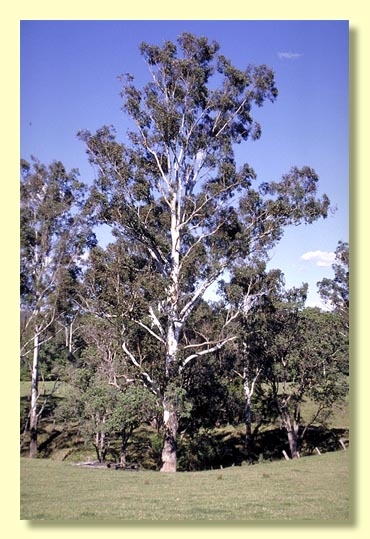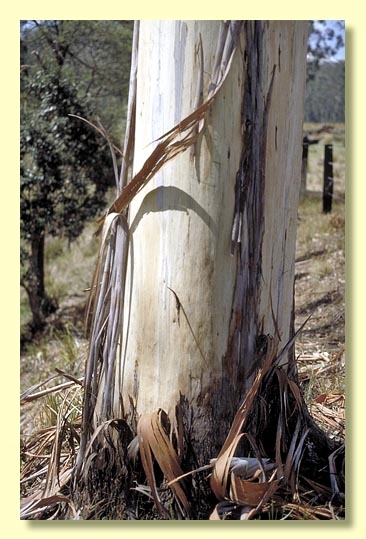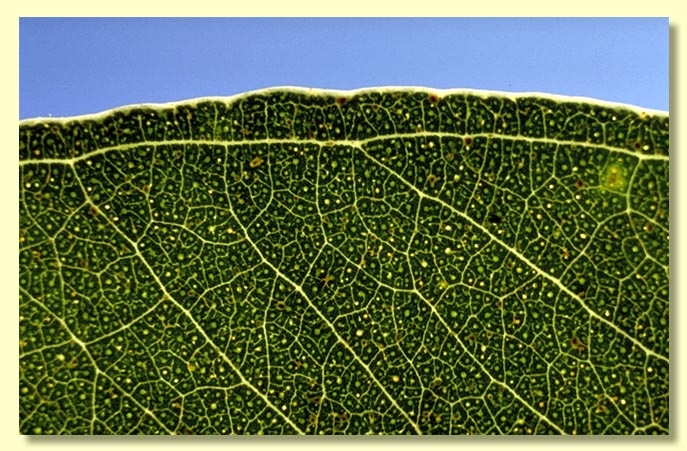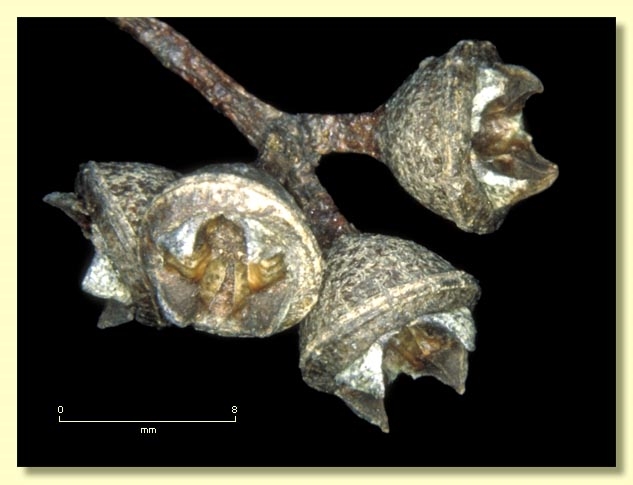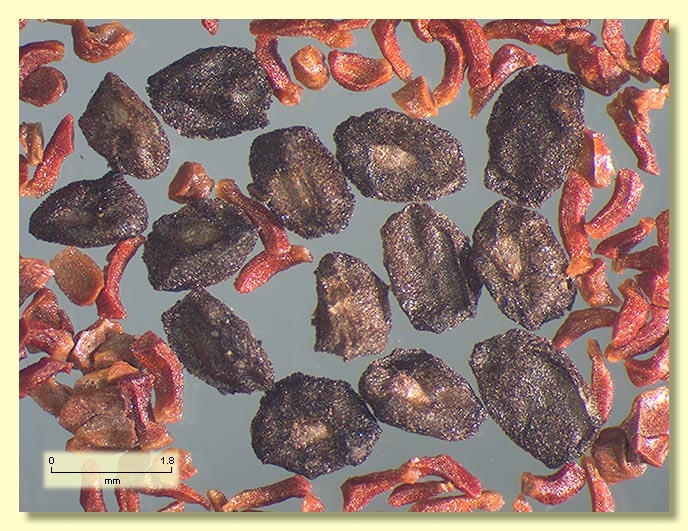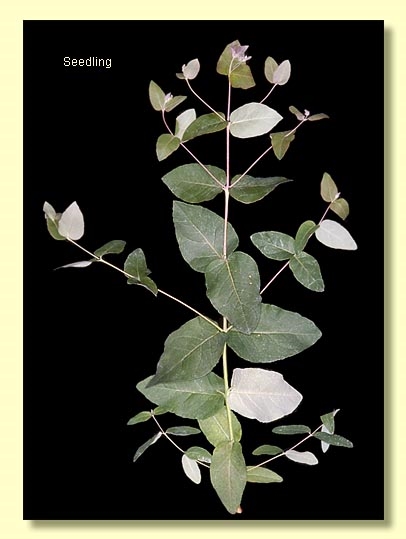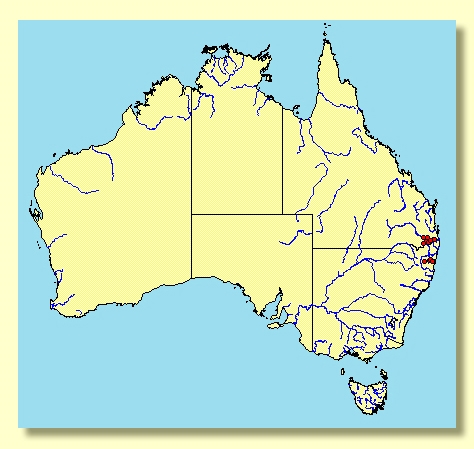Euclid - Online edition
Eucalyptus dunnii
Eucalyptus | Symphyomyrtus | Maidenaria | Euryotae | Bridgesiana
T: New South Wales. Acacia Creek, Macpherson Range, W. Dunn 88, 1 May 1905; holo NSW (3 sheets) [NSW 313318, NSW314312 & NSW313319]; fide Bean, A.R., Telopea 12(3): 312 (2009).
Bark rough for up to 4 m then smooth; rough bark loose basal slabs or corky, grey or brown; smooth bark usually white to cream, with patches of yellow, grey or green, long ribbons often hanging from crown.
Branchlets rarely glaucous.
Juvenile growth (coppice or field seedlings to 50 cm): stem rounded or square in cross section, warty or smooth; juvenile leaves opposite, shortly petiolate at first, becoming sub-opposite for many pairs, orbicular to ovate to elliptical, 2.5–15 cm long, 1.8–11 cm wide, initially lobed at the base but eventually truncate, margin entire or crenulate, discolorous, green or grey-green; new growing tips slightly glaucous.
Adult leaves alternate, petiole 1.5–4.5 cm long; blade lanceolate to falcate, 8–30 cm long, 1.5–4 cm wide, base tapering to petiole, concolorous or slightly discolorous, glossy, green, side-veins greater than 45° to midrib, moderately to densely reticulate, intramarginal vein parallel to and well removed from margin, oil glands mostly island.
Inflorescence axillary unbranched, peduncles 0.7–1.6 cm long, buds 7 per umbel, pedicels 0.2–0.6 cm long. Mature buds ovoid, 0.6–0.7 cm long, 0.3–0.5 cm wide, green or rarely glaucous, smooth, scar present, operculum beaked or conical to rounded, stamens inflexed or irregularly flexed, anthers cuboid or cuneate, versatile, dorsifixed, dehiscing by longitudinal slits (non-confluent), style long, stigma blunt, locules 3 or 4, the placentae each with 4 vertical ovule rows. Flowers white.
Fruit usually pedicellate, rarely sessile, (pedicels (0)0.2–0.5 cm long), cup-shaped, obconical, or hemispherical, 0.4–0.6 cm long, 0.5–0.9 cm wide, rarely glaucous, disc raised-convex to annular, or flat, valves 3 or 4, exserted.
Seeds black or brown, 1.5–3 mm long, ovoid or flattened-ovoid, often pointed at one end, often lacunose, dorsal surface smooth or pitted, hilum ventral.
Cultivated seedlings (measured at ca node 10): cotyledons bilobed; stems rounded in cross-section, slightly warty, sometimes glaucous; leaves shortly petiolate, opposite for at least 13 nodes, ovate or cordate, 5–7.5 cm long, 2.5–4.5 cm wide, base slightly lobed, margin entire or subcrenulate, apex pointed, discolorous, darker green above, becoming glossy.
Flowering time not recorded.
A medium-sized to very tall forest tree of restricted distribution from west of Coffs Harbour in the Nymboida and Border Ranges area north to far south-eastern Queensland, e.g. Mt Mitchell, Spicer's Gap, near Killarney and south of Canungra. It has rough bark up to 4 m m then smooth bark over most of the trunk and has grey-green juvenile leaves.
Eucalyptus dunnii belongs in Eucalyptus subgenus Symphyomyrtus section Maidenaria, a large group of species more or less restricted to south-eastern Australia, characterised by bilobed cotyledons, simple axillary inflorescences, buds with two opercula, stamens with versatile anthers and flattened seeds with a ventral hilum. Within this section, E. dunnii belongs in series Bridgesianae having some basal rough bark, ovate, crenulate juvenile leaves opposite for many nodes, small ovoid buds in sevens, and small fruit with exserted valves. The other species in series Bridgesianae are E. bridgesiana, E. angophoroides and E. malacoxylon, which are wholly rough-barked with glaucous juvenile leaves (green to grey-green in E. dunnii).
E. dunnii may be confused with E. saligna, with which it may grow, but this latter species is easily distinguished by its strongly discolorous adult leaves.

